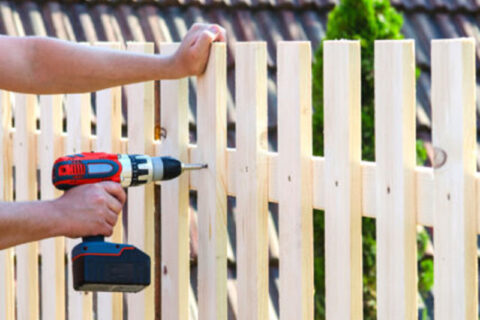How to Build a Privacy Fence: A Complete Guide
There are over 1 million residential burglaries in the United States every year. Learning how to build a privacy fence not only provides security, it will also increase the marketability of your home.
Based on factors such as fence material and placement, fences made of wood and other solid materials can net around a 50% return on the cost for materials and installation at the time of sale.
Preparing to Build
There are several steps to consider whether building a fence on your own or hiring a company to handle the installation.
Determine Fence Height
Consider the fence height needed to get the privacy you desire. Keep in mind that the rise and fall of the ground, combined with things such as decks connected to neighboring homes, will determine how high your fence needs to be for full privacy.
Check City and Homeowner’s Association Regulations
Before ordering materials check into local ordinances, regulations, and building codes. If you install a fence that violates those rules, you may be ordered to take the fence down. You will also need to check any homeowner’s association rules.
Some cities require you to obtain a builder’s permit. There may be height restrictions on fencing. There will likely be setbacks from property lines, sidewalks, and roads.
Survey Your Property and Advise Neighbors
Walk around your property and locate the metal property line markers. Do not assume your property is square.
If you are unable to find the property markers, you need to have it professionally surveyed. This should also be done if you are replacing an existing fence. Do not assume that a prior homeowner was diligent in making sure fence placement was correct.
Contact all utility companies to prevent digging into underground wires or piping. Those companies will come out and mark the areas where wiring is present.
Talk to your neighbors and advise them of your plans. This can alleviate hard feelings after the installation. It might also prove to be financially beneficial if they are also considering a fence. You can coordinate style and installation, sharing the cost of fencing on a joint property line.
Select the Fence Material
There is a wide selection of fence material, offering everything from decorative, security, and total privacy. When selecting material, consider the material’s life expectancy, required maintenance, and cost. If building the fence yourself, ease of installation is also a consideration.
Cedar
Cedar is popular due to its long-lasting good looks. This wood naturally resists decay and insects, never warps or shrinks, has a tight grain, fewer knots, and a beautiful red hue that weathers to a silvery grey. It is recommended that posts be made of treated wood, as the cedar is likely to rot after several years.
Cedar requires a penetrating sealant immediately after installation and every year after to maintain its natural color.
Vinyl
Vinyl will continue to look good for the longest period of time. Some vinyl has a lifetime warranty. It is almost maintenance-free, requiring only washing with a mild detergent and a rinse with the garden hose.
The installation of vinyl must be very precise for the fence to look good. For this reason, it is recommended that vinyl fencing be professionally installed.
Treated Wood
Treated wood fences are wallet-friendly and offer privacy. It resists insects and moisture, making it a good choice for fence posts. Pickets do have a tendency to warp or twist after installation. The wood should be sealed or painted for a better appearance.
How to Build a Privacy Fence
Building a privacy fence can be a rewarding but challenging task. The steps to build a privacy fence must be executed carefully.
The style of your privacy fence may be solid, where all pickets are attached tightly together on the outside, fully blocking the view and offering full privacy. If you build a shadowbox wood fence the pickets will alternate on each side of the fence. This allows you to look through the fence at an angle but still offers privacy.
Layout Placement of the Fence
Determine where you want the gates to be placed and use spray paint to mark the ground. There are six security gate styles, two for walking and four for driveways. Be sure to make your gate wide enough for the passage of any lawnmowing equipment to pass through.
Another consideration is whether you want more than one gate. Possibly placing one on the opposite side of the house or exiting the back of your yard.
Measure and document gate sizes needed. Subtract the gate footage from the fence footage when determining how much fencing material is required. Outline the proposed fence line with string or a chalked measuring wheel.
Constructing the Fence
When building a fence the “pretty” side must face the street or neighbors. The backside of the fence with the visible wood rails goes inside the fence. This is generally a city and homeowner’s association regulation and also adds to the curb appeal of your home.
Position fence posts every 6-8 feet. Keep post spacing consistent. Post holes should be dug approximately 33% as deep as the fence height, plus add a few additional inches for gravel.
Pour 3-4″ of pea gravel into the hole, then add 6-8″ of concrete mix. Position the pole in the concrete mix, slope the concrete away from the post, and plumb the post with a level. Add water and allow it to seep into the cement mix.
Follow the manufacturer’s instructions for drying and curing the cement, which is up to three days. Once the cement has cured you can attach the fence rails or panels to the posts by securing them with No. 8 2-1/2″ deck screws or galvanized 10d x 3″ nails.
The pickets are then attached to the rails, again using No. 8 2-1/2″ deck screws or galvanized 10d x 3″ nails. Be sure to align the top edge of each picket with the one next to it. If using post caps, tap them on with a rubber mallet until they are snuggly on the post.
Finishing the Fence
Apply stain, paint, or weatherproof finish to the wood. A wood preservative should be applied around the base of the posts to prevent them from rotting. Apply a new cote every 2-3 years.
If the fence is built with pressure-treated wood, wait until the wood has fully dried before applying any stain or paint.
Do-It-Yourself or Professional Installation
Learning how to build a privacy fence is a fun project. If you would rather not tackle a job of this size, let professionals with over 15 years of fencing experience handle it for you. Contact Florida State Fence for information and a free quote.


